
Seasonal wildflowers give color to Tetons
JACKSON HOLE, Wyo. — Few landscapes in the world are striking and remarkable as that of Grand Teton National Park. Rising abruptly from the ground of the valley, the mountains give to visitors a testimony of the nature’s magnificence.
But, as striking as the mountains, lakes and wildlife are, for me, it is the park’s wildflowers that truly add that last subtle touch to this natural masterpiece.
| Click on the video at the right to view a slideshow about the flora of Grand Teton National Park prepared by writer Sandy Florez. Photography by Antonella Stelluto and some images courtesy of the National Park Service. |
During my short trip on early October to Grand Teton National Park near here, I was now and then uploading to my cell phone some photos of the places I was visiting, the town I was staying at, the little things that caught my attention and of the nature itself, which is breathtaking enough to turn any picture into a great desktop screensaver.
The response from my friends was straight away. Within seconds, I received a message from a friend, Nathalie.
“What an amazing landscape,” she wrote. “The explosion of colors is what makes the picture even more awesome.”
| Musk thistle at the Grand Teton National Park tend to be confused with Canada thistle, which are similar looking thistles. These exotic red flowers grow up to six feet tall, and can form dense stands in open fields (Photo courtesy of the National Park Service). | 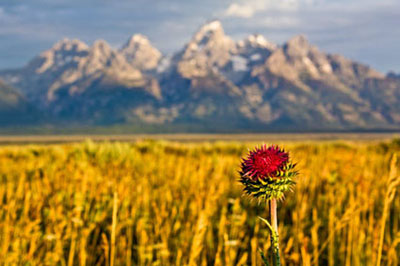 |
And the flora of the Grand Teton mountains is indeed awesome.
If you visit the Teton, especially during summer, you would soon realize than wildflowers are just like a colorful fancy gown that the Grand Teton only wears once a year. A display of reds, oranges, yellows, whites, pinks, blues and purples dresses the ground and mountainsides of the park.
The blooming of wildflowers of the Grand Teton region can vary each time in intensity, duration and prominence of the species. Yet, there are several types of wildflowers that loyalty show up each year.
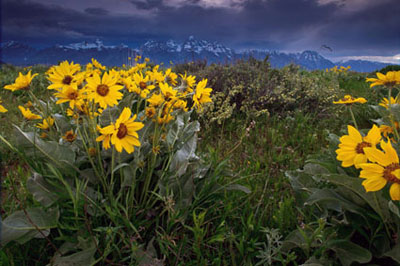 |
Flowering in June, Balsamroots grow in large conspicuous bunches with stems up to 2 feet tall. These yellow wildflowers are very showy in the park. They often cover entire meadows or hillsides in early summer (Photo courtesy of the National Park Service) |
The National Park Service estimates that more than 1,000 species of plants and wildflowers grow in Grand Teton National Park and its surrounding areas.
Throughout summer, snow gradually disappears up the mountain slopes. As the snow melts, wildflowers start, little by little, to color the different regions of the Teton. The wildflowers usually bloom from May through September and, on occasions, can last until late August.
The warm weather arrives first in the Jackson Hole Valley. Yet, there are only 60 to 70 frost-free days a year in most areas of the park. For that reason, most flowers appear for only a short time and the seasonal displays of color occur rapidly.
| At right, one-flower Helianthellas bloom in small bunches with stems as tall as four feet. These yellow wildflowers look very similar to sunflowers. Hilianthellas can be found in moist meadows, especially close to aspen trees that are near water. Next below, with the arrival of fall, the varieties of deciduous trees provide beautiful colors, which complement Teton itself. Colored foliage of aspens and golden willows adorn many areas (Photos courtesy of the National Park Service). | 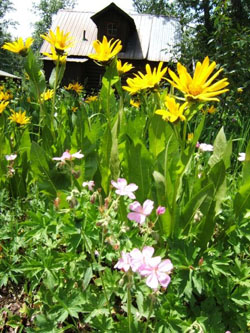 |
“Flowers start to lose their petals with the arrival of fall,” said Nick Myers, a plant expert and ranger of the Craig Thomas Discovery and Visitor Center at Moose at the park’s south entrance.
Summer is definitely the opportunity for admire all kind of wildflowers at the Teton from the rarest flower species, which strangely can be found on the most frequently visited areas of the park, to the most common ones.
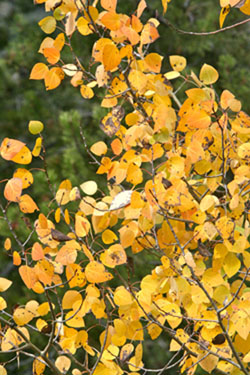 “Rabbitbrush is probably the most common seasonal flower in the park,” said Myers. “Another common wildflower found in meadows and near sagebrush is the Silvery Lupine.”
“Rabbitbrush is probably the most common seasonal flower in the park,” said Myers. “Another common wildflower found in meadows and near sagebrush is the Silvery Lupine.”
Luckily, those who visit the Grand Teton during late August and early October still have a chance to find several wildflowers, rare and common, adorning the hillsides and different areas of the park before the first autumn frost arrives.
“The common wildflowers often line the trails through conifer forests, mark the streams and springs in the foothills, or highlight meadows in the mountain canyons,” wrote Charles Craighead, a natural history writer and author of the Common Wildflowers of Grand Teton National Park.
From September through late October temperature start to cold down. The average daily temperature at the Teton is 62 degrees, although it can significantly decrease during nighttime. Warm sunny days can be commonly interrupted with rain showers or snow.
A variety of factors, such as soil conditions, availability of moisture, or elevation is what ultimate determine where plants grow.
In Grand Teton National Park, there are three distinct zones where the flowers grow – the forest floor, the sagebrush valley and the alpine zone.
“Blooms range from entire meadows of waist-high flowers to single, dwarf alpine plants,” wrote Craighead.
Many species of wildflowers and plants in general require similar conditions to flourish, which is the reason why different variety of flowers can all be seen in the same area.
The rocky soil floor of Jackson Hole Valley, for instance, provides the ideal environment for silvery-green big leaf sagebrush to grow.
The Snake River or other wetland areas are the home of many moisture-loving plants.
| At right, snow covers higher slopes of the Grand Teton National Park during early October. The park preserves a spectacular landscape abounding in magnificent mountains, lakes and extraordinary wildlife and vegetation. Next below, aspen is one of the most beautiful trees in the park. During the fall, aspen leaves turn into different range of yellows. The Snake River has a beautiful display of fall colors. Last, Parry primroses growth in the mountains of the park are relatively large in size. Flowers normally spread out in small bunches of three to 10 flowers (Photos by Antonella Stelluto). | 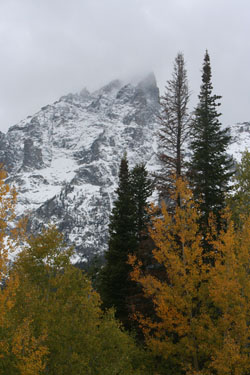 |
Moist meadows, for instance, offer the suitable conditions for grasses, sedges and several white wildflowers like white mules ear, Englemann aster, Colorado columbine and Rocky Mountain parnassia, just to name a few.
The conditions at canyons, mountainsides and hills support the growth of trees. Conifers trees dominate these areas, coloring the landscape with dark greenish tones and adding a unique smell, to this already perfect environment, that can not be bought in any essence’s store.
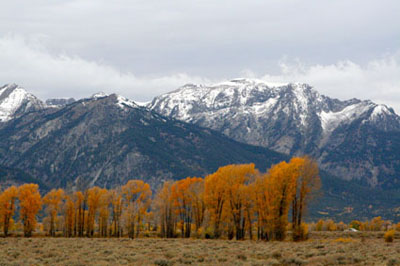 The alpine zone’s wildflowers are generally very small and grow close to the ground.
The alpine zone’s wildflowers are generally very small and grow close to the ground.
“The alpine zone, it’s really special. They get a very short window of opportunities to grow flowers,” Myers said. “This year, for instance, the snow did not melt until the middle of August so, they only had as little as one month to grow.”
If you are looking for really eye-popping flower colors, then look for some of the following list of wildflowers when you visit the Grand Teton or surrounding areas.
Some of them can only be admired for a very short period of time, but they are definitely worth enough to make the visit:
- The Lewis monkeyflowers, which have an outstanding combination among bright yellow center and its five rose-pink petals. These pink wildflowers can be normally fond in moist areas or lying over the water.
- The wild rose is a very bright fuchsia and yellow flower that can be found in many areas of the park. Its fruit is an important food for the wildlife during winter.
- Blue penstemons belong with the purple and blue wildflower family. These flowers can be seen in different places, preferably in dry or open ground areas of the park. Their color can range from deep blue to paler tones like lavender.
- Yellow monkeyflowers are very bright yellow flowers that can vary in size and shape with its location. The small red spots on its petals aim to attract insect pollinators.
- The alpine forget-me-not is the official Grand Teton National Park. It is my absolute favorite because of its bright blue-purplish color. It is hard and rare to see flowers that can displays true blue color
“These seasonal flowers do not change their colors,” Myers said. “Their color and shape play very specific factors in the pollination process.”
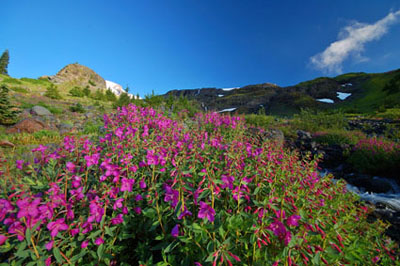 Because all plants and animals are important part of the ecosystem, show some respect for them is extremely valued at the Teton Park. While you are visiting, avoid going across wildflower fields. Aim to preserve the vegetation for others to enjoy.
Because all plants and animals are important part of the ecosystem, show some respect for them is extremely valued at the Teton Park. While you are visiting, avoid going across wildflower fields. Aim to preserve the vegetation for others to enjoy.
Grand Teton National Park is certainly a unique place. The minute I started to admire its picture-perfect scene through the window of the car, I understood how the many hours of travel I spent to get there more than worth it.
If You Go
- What: Grand Teton National Park
- Where: U.S. Routes 26/89/191, Jackson Hole, Wyo., 83012
- When: From June through early October

Comments are Closed